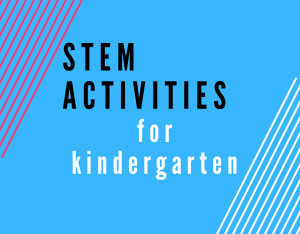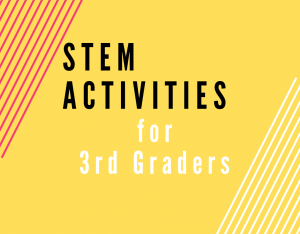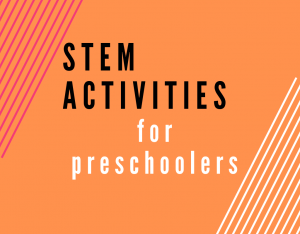Are you looking for STEM activities for seventh-graders? This can be a difficult task, mainly because STEM is pretty new. Many STEM activity resources do not provide enough information, while others have so much information that it can get confusing. Resources that have little information usually depend on you trying to figure out the rest hoping it’ll turn out OK. The resources with too much information usually try to point out and explain all the teaching standards covered for not just one, but a span of grades. This makes the STEM activities seem more tedious then they have to be, and leaves you to think twice about facilitating them.
To simplify things, I created this page. I list projects that aren’t too difficult to facilitate, while still being effective in advancing STEM learning for seventh graders. Each activity includes a materials list, a description, how to, STEM content, and what to say and ask.
Table of Contents
Roller Coaster Physics
Materials
- stopwatch
- blank sheet of paper
- set of markers, crayons or pencils
- roll of masking tape
- paper or plastic cup
- steel marble
- wooden marble
- glass marble
- 2-meter (6 foot) long foam tube (1/2″ pipe insulation) cut in half lengthwise
Description
Students explore the physics used by engineers in designing roller coasters, including potential and kinetic energy, gravity, and friction. They will first learn that all authentic roller coasters are driven by gravity and that the conversion between potential and kinetic energy is crucial to all roller coasters. Second, they will learn about the role of friction in slowing down roller coaster cars. Lastly, they study the acceleration of roller coaster cars as they travel around the track. Students will design, build, and analyze model roller coasters they make with foam tubing and marbles.
How To
- Cut each tube lengthwise in half. These are to be used as the roller coaster track for the marbles as cars. Give each group a half.
- Divide the class into groups with three or four students each.
- Tell the students that the glass marble simulates a normal car, the wooden marble represents an empty car, and a steel marble represents a full car. Their team will earn points for each type of marble (passenger load) that completes their track and lands safely in the cup successfully. A class competition will determine the most innovative and successful roller coasters.
- Have groups start designing their roller coasters, sharing ideas, brainstorming, and agreeing on a design. Have students draw their roller coasters on paper, make signs, and name them. Look over their drawings to make sure that their designs are physically possible. If not, point out those aspects of the roller coaster design and ask if they may want to rethink.
- Give each group a foam tube track, masking tape, and cup. Have them build their roller coasters using classroom materials using the cup to catch the marble at the track end.
- Give students marbles to test their roller coasters. Allow them to make any necessary changes.
- Hand each group a stopwatch to determine certain specifications of their roller coasters.
- Start the class competition by telling the students about how engineers create small-scale models to help them test and analyze their structural designs. For example, the Golden Gate Bridge in San Francisco was designed by engineers pioneering new suspension bridge design theory. They verified their calculations of the forces it would need to withstand by performing tests on a steel tower model 56 times smaller than one of the actual bridge towers. The tests confirmed the tower calculations of the anticipated forces, and the bridge still stands today, more than 75 years later.
- Have each group present its roller coaster model to the class. Discuss the results.
Science Content
This STEM activity for seventh-graders aligns with two Next Generation Science Standards:
MS-ETS1-4: “Develop a model to generate data for iterative testing and modification of a proposed object, tool, or process such that an optimal design can be achieved.”
MS-PS3-5: “Construct, use, and present arguments to support the claim that when the kinetic energy of an object changes, energy is transferred to or from the object.”
Engineering Content
Students explore crucial parts of the initial design process for roller coaster engineers. They learn about the limitations and possibilities of roller coasters within energy conservation, frictional losses, and other physical principles. After the activity, students should be able to analyze any existing gravity-driven coaster’s motion and design the basics of their own model roller coasters.
What to Say and Ask
- Which roller coasters were the safest? Which were the most exciting?
- Which won for safety and performance? Which won for creativity?
- Which model met the overall challenge for both safety and thrilling design best? Can you tell the trade-offs?
- From testing your model, what did you learn?
- What improvements would you make if you were to redesign your model?
- What would happen if you ignored the fundamental laws of physics in your designs? Would the same thing happen to engineers in real-life?
- How important is it that engineers test their designs before they are built?
- What design steps and techniques in engineering did we use today? (Answer: Brainstorming, modeling, simulation, testing, analyzing, redesign, optimization)
Sources
- https://www.teachengineering.org/lessons/view/duk_rollercoaster_music_less
- https://www.teachengineering.org/activities/view/duk_rollercoaster_music_act
Types of Bridges
Materials
- 1 small sponge or flat eraser
- 1 dark ink pen or marker
- 1 strip of cardboard or poster board (1-in wide x 11-in long; 2.5-cm wide x 28-cm long)
- 1 10-foot piece of string or small diameter rope
- 1 11-foot piece of rope
- several textbooks
Description
In this activity, students will learn about three major types of bridges, identify tension and compression forces, and build models to discover where and how those forces act on each of the bridge types. At the end of the activity, students may develop their own model bridge to fulfill a function, deciding on the best type of bridge for each.
How To
- Prepare the following materials for each group:
- For the beam bridge model, use a pen or marker to draw equally-distant parallel lines along the width of the sponge or eraser. Dampen the sponge so it can flex.
- Cut cardboard into strips for the arch bridge.
- Cut the string into three 2-foot lengths and one 4-foot piece for the suspension bridge.
- Cut the larger-diameter rope into one piece 5-feet long and another piece 6-feet long for the cable-stayed bridge.
- Have the class go into groups of two students each.
- Present the basic concepts of the beam, arch, and both suspension bridges. Discuss the compression and tension forces present in each bridge and the differences in each.
- Have each group make a simple beam bridge. Position two stacks of textbooks of about equal height (3-4 inches) so that the flat sponge can bridge between them (make distance between the stacks about 1-2 inches. Lay the sponge on the two textbook stacks spanning the range between them. Place just enough downward force on the top of the sponge using a pen or pencil to cause it to bend but not completely collapse.
- What do you notice about the parallel lines drawn on the top and bottom? (Answer: The top lines move closer together. The bottom lines move farther apart.)
- What location are the compressive forces found? (Answer: The compressive forces are found on the top.)
- What location are the tensile forces found? (Answer: The tensile forces are found on the bottom.)
- Have each group make a simple arch bridge. Tell them to bend their cardboard strips gently so that they curve. Then, put the cardboard strip on a flat surface so that it looks like an arch. Place a downward force on the top of the center of the arch using a pen or pencil. What happens to the arch? (Answer: the arch collapses because its ends move outward.) Next, place two stacks of textbooks about 5-6 inches apart. Place the arched cardboard strip in-between the two stacks resembling an arch bridge. Apply pressure on the center of the arch (see Figure 2).
- What happens now? (Answer: The arch should not collapse as easily.)
- What kind of force do the abutments (textbooks) put on the arch, pushing (compression) or pulling (tension)? (Answer: Since the arch is pushing on the abutments, the abutments push back on the arch.)
- Have each group make a simple suspension bridge. First, tie one of the 2-foot long pieces of string around the middle of one 1-inch thick textbook while it is laying flat on the table. Do this again with the other 2-foot long piece of string and a different textbook. Stand the two textbooks on end with the string at the top. Take the third piece of 2-foot long string and tie each end to the string on the tops of the textbooks. Put the textbooks about 18 inches apart. Now, push down on the string that connects the two textbooks. What happens? (Answer: The books fall inward easily.)
- Next, take the strings off of the two textbooks. Take the 4-foot long piece of string and put a stack of textbooks on top of one end. Put another stack of textbooks on the other end. Using the same 1-inch thick textbooks as in step 5, place them under the string standing on end. Try to make the distance between the two textbooks the same as before, 18 inches. Now, put pressure on the string between the two textbooks.
- What happens? (Answer: The books do not fall as easily, even with increasing load.)
- Is the string in tension or compression? (Answer: The string is in tension; it can only support a tensile force.)
- Are the books in tension or compression? (Answer: The books are in compression.)
- Do the stacks of books push or pull on the string? (Answer: Since the string is pulling on them, he stacks of books pull on the string.)
- Point out how the bridge is stabilized with the help of the anchorages (textbook stacks).
- Have each group make a simple cable-stayed bridge. Have students stand then hold out their arms to each side. Tell them to imagine their arms are a bridge and their head is a tower in the middle. Their muscles are holding up their arms in this position. Now, have the students become cable-stayed bridges using the rope. Using the 5-foot piece of rope, tie each end around each elbow. Place the centers of the ropes on the tops of their heads. The rope acts as a cable-stay by holding up the elbows. Repeat this process using the 6-foot piece tying the ends around their wrists.
- Where do you feel a pushing or compression force? (Answer: The ropes are in tension from the arm weight while their heads are in compression.)
- Notice how the arm weight (load) is transferred to the tower (heads).
- Conclude the activity by having students design their own bridge. For example, have each team pick one type of bridge to design. Using their notes, have them create a drawing of the bridge in an appropriate location. For example, a modern suspension bridge might be used across a body of water that is 3,000 ft in length.
Science Content
This STEM activity for seventh-graders aligns with two Next Generation Science Standards:
MS-ETS1-2: “Evaluate competing design solutions using a systematic process to determine how well they meet the criteria and constraints of the problem.”
MS-PS2-2: “Plan an investigation to provide evidence that the change in an object’s motion depends on the sum of the forces on the object and the mass of the object.”
Engineering Content
Students design their own bridges using the introduction section here and their findings from the models to come up with solutions to problems. You will want to specify criteria and constraints, focusing on ideas from the models.
What to Say and Ask
Ask students the questions provided throughout the “How To” section and discuss it as a class.



